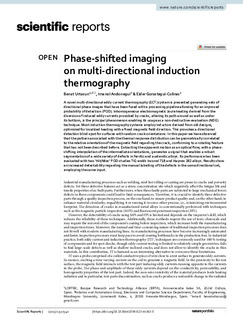| dc.rights.license | Attribution 4.0 International | * |
| dc.contributor.author | Urtasun Marco, Beñat | |
| dc.contributor.author | Andonegi, Imanol | |
| dc.contributor.other | Gorostegui-Colinas, Eider | |
| dc.date.accessioned | 2024-03-26T13:54:25Z | |
| dc.date.available | 2024-03-26T13:54:25Z | |
| dc.date.issued | 2023 | |
| dc.identifier.issn | 2045-2322 | en |
| dc.identifier.other | https://katalogoa.mondragon.edu/janium-bin/janium_login_opac.pl?find&ficha_no=174267 | en |
| dc.identifier.uri | https://hdl.handle.net/20.500.11984/6322 | |
| dc.description.abstract | A novel multi-directional eddy current thermography (ECT) system is presented generating sets of directional phase images that have been fused with a processing pipeline allowing for an improved probability of detection (POD). Inhomogeneous electromagnetic Joule heating derived from the diversion of induced eddy currents provoked by cracks, altering its path around as well as under its bottom, is the principal phenomenon enabling its usage as a non-destructive-evaluation (NDE) technique. Most induction thermography systems employ inductors derived from old designs, optimized for localized heating with a fixed magnetic field direction. This provokes a directional detection blind-spot for surfaces with random crack orientations. In this paper we have observed that the pattern associated with the thermal response distribution can be geometrically correlated to the relative orientation of the magnetic field regarding the crack, conforming to a rotating feature that has not been described before. Extracting the apparent motion as an optical flow, with a phase-shifting interpolation of the intermediate orientations, generates a signal that enables a robust segmentation of a wide variety of defects in ferritic and austenitic alloys. Its performance has been evaluated with two ‘Hit/Miss’ POD studies TIG welds Inconel 718 and Haynes 282 alloys. Results show an increased detectability regarding the manual labelling of the defects in the same directional set, employing the same input. | en |
| dc.language.iso | eng | en |
| dc.publisher | Springer Nature | en |
| dc.rights | © 2023 The Authors | en |
| dc.rights.uri | http://creativecommons.org/licenses/by/4.0/ | * |
| dc.subject | ODS 9 Industria, innovación e infraestructura | es |
| dc.title | Phase-shifted imaging on multi-directional induction thermography | en |
| dcterms.accessRights | http://purl.org/coar/access_right/c_abf2 | en |
| dcterms.source | Scientific Reports | en |
| local.contributor.group | Robótica y automatización | es |
| local.description.peerreviewed | true | en |
| local.identifier.doi | https://doi.org/10.1038/s41598-023-44363-5 | en |
| local.contributor.otherinstitution | https://ror.org/04z0p3077 | en |
| local.source.details | Vol. 13. N. art. 17540, 2023 | |
| oaire.format.mimetype | application/pdf | en |
| oaire.file | $DSPACE\assetstore | en |
| oaire.resourceType | http://purl.org/coar/resource_type/c_6501 | en |
| oaire.version | http://purl.org/coar/version/c_970fb48d4fbd8a85 | en |
| oaire.funderName | Gobierno Vasco | en |
| oaire.funderIdentifier | https://ror.org/00pz2fp31 / http://data.crossref.org/fundingdata/funder/10.13039/501100003086 | en |
| oaire.fundingStream | Elkartek 2022 | en |
| oaire.awardNumber | KK-2022/00024 | en |
| oaire.awardTitle | Producción Fluída y Resiliente para la Industria inteligente (PROFLOW) | en |
| oaire.awardURI | Sin información | |
| dc.unesco.campo | http://skos.um.es/unesco6/33 | en |








